Author Gregory Terian
Fifty-five years have elapsed since the composer’s death and one would have expected all his mature works to have been committed to disc by now. Surprisingly, a few outstanding gaps in the recorded repertoire remain, the pastoral opera being one of them.
In 2007 Supraphon planned to record the work coupled with The Strangler, a ballet score from 1948 [also unrecorded] but the project was abandoned.
The year 1951 saw the advent of the television opera. The outstanding success of Menotti’s Amahl and the Night Visitors led other composers to engage with the new medium. It coincided with a vogue in one-act chamber operas, the format being popular with opera workshops, particularly in America.
What Men Live By was completed in early 1952. It was based on a fable by Tolstoy about a humble cobbler’s dream of a visitation by Christ and the events which followed. The English language text was devised by the composer himself. Of approximately 40 minutes duration, it was planned as a companion piece for The Marriage which followed shortly after. Both were conceived in the wake of a successful theatre adaptation of the Comedy on the Bridge, originally composed for radio back in 1935. In an article by Ross Parmenter published in the New York Times on 13 April 1952 the composer outlined the circumstances leading to the creation of the new work.

Whereas The Marriage achieved an early production by NBC Television on 7 February 1953, performance details relating to What Men Live By have remained obscure. Safranek’s 1964 biography listed a performance in New York City in May 1953. Halbreich [1968 & 2007] endorsed the date and indicated that it was a television production.[It was listed as H.336 in the Halbreich catalogue, The Marriage being designated as H.341.] Both works were published by Boosey & Hawkes in 1953.
An extensive search of contemporary notices in the American musical press failed to identify any performance of What Men Live By in May 1953. Additionally, Boosey & Hawkes kindly produced copies of internal correspondence dating from April-June 1953 indicating their intention to publish the score in the latter part of 1953.
It was already known that there had been a staging of the work the following year during the annual National Music Camp at Interlochen organised by the University of Michigan. Further enquiries established that this had been a small-scale student workshop production with piano accompaniment in lieu of an orchestra. It was billed as the American premiere and took place on 1 August 1954 at the little Grunow Theater which had an audience capacity of no more than 250.
At this stage of my enquiries I chanced on a 1994 edition of Baker’s Concise Musical Guide which cited 20 May 1955 as the date of the first performance. A subsequent trawl of relevant American press notices established that the Hunter College Opera Association had performed the work on that date in New York as part of a triple bill of new works by Martinu, Tcherepnin and Meyerowitz. The supporting orchestra was directed by Francois Jaroschy. Although announced as the New York premiere, it appears to have been the first realisation of the opera with orchestral support and as such, effectively, a world premiere. The performance took place at the Hunter College Playhouse. It was not televised or broadcast and there is no extant recording.

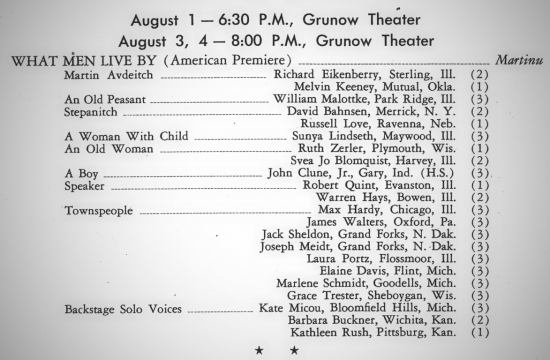
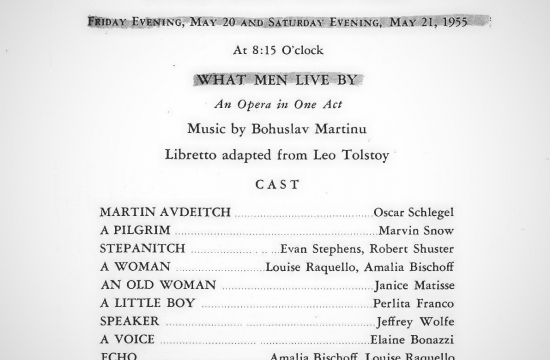
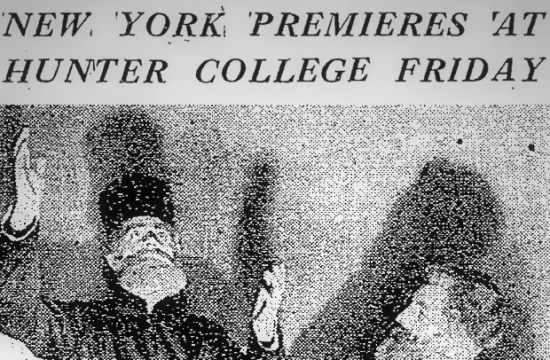
The new work attracted some positive reviews. Howard Taubman [NY Times] remarked on its mood “overflowing with melodic and rhythmic feeling evoking the composer’s homeland”; but he was critical of an over-robust approach on the part of the conductor and hoped that the volume would be toned down in later performances. In passing, it should be noted that Jaroschy was born in Prague and was a product of the Prague Conservatoire where he had studied with Zemlinsky. An impressive CV listed performances with Radio Prague and the Berlin State Opera and he was credited with
introducing Janacek’s Jenufa to Paris audiences after the war.
The following year Martinu’s friend Zdenek Zouhar instigated a performance of What Men Live By in Brno using a Czech text with piano accompaniment. In a letter to Zouhar dated 11 March 1956, the composer set out his vision of the work along with performance suggestions;-
Many thanks for your letter and all the kind news about your endeavours to promote martinu. It gives me great pleasure. I am interested in your idea of promoting Tolstoy. It could be performed in a concert version with piano. It actually concerns a type of old play called Miracle, religious and at the same time folk plays that can be performed anywhere, in fact it is not a theatre play as such, it is static and something like the legend of Dorothy. My own and main condition is that it must not be played “pathetically” but joyfully. That is why it is called opera-pastoral. The text tends a lot to be very serious and “deep” but that was not my plan. For me it is a rather cheerful work and the listener must not feel a religious-like moral but joy. The moral is precisely in joy…………….. With regard to the concert direction aspect, I think that the piece should actually be performed on stage without scenery……the actors would not act but sing and reduce gestures to the most essential………. The small chorus would be somewhere on stage. As regards costumes, I think they should be everyday “civvies”, i.e not in dinner jacket, but neither somehow costumed. This is also explained in the text by the speaker. So that is maybe everything I would want.
Initially it seemed that Martinu’s aspirations for his new chamber opera would be realised. It was staged by a number of American colleges and universities. The BBC was actively considering a television production of the work in late 1955 but nothing came of the project. A European premiere took place on 3 March 1956 at the Regensburg opera house but was not well received by the critics. With the passage of time interest waned and performances became few and far between. In Czechoslovakia there were productions by the opera houses at Plzen [1964/65] and Brno [1974/75 & 1989/90] using a Czech text but no recordings appear to have survived.
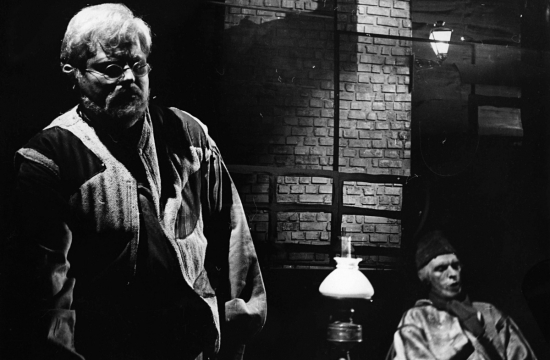
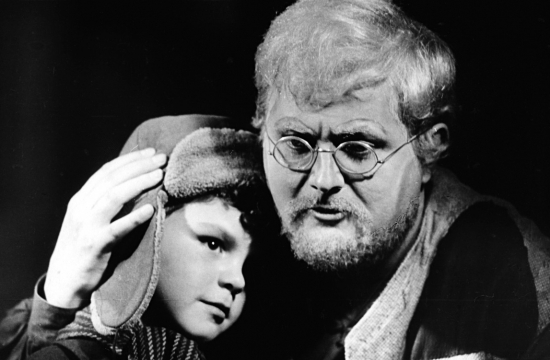
The coming festival Bohuslav Martinu Days will present an opportunity of hearing the original English language version of the opera for the first time in many years. With maestro Belohlavek at the helm of the Czech Philharmonic and with an all-Czech cast, one can be assured of authoritative performances of the highest calibre. And with a world premiere recording due to follow, all Martinu enthusiasts will soon be able to experience the spirit of joy which the composer sought to create with his unique vision of a pastoral opera.
Jiří Bělohlávek talks about What men live by
The author wishes to acknowledge assistance from the following: Karl Miller, Byron Hanson, Interlochen Arts Center archivist, Professor Julio Hernandez-Delgado and Maria Enaboifová, Hunter College Libraries, City University of New York [archive and special collections], David Allenby, Boosey & Hawkes London, Zoja Seyčková, Bohuslava Martinů Institute, Prague.
Editor’s note
The article was originally published in Martinů Revue, Vol. XIV, No. 2
(May – August 2014).
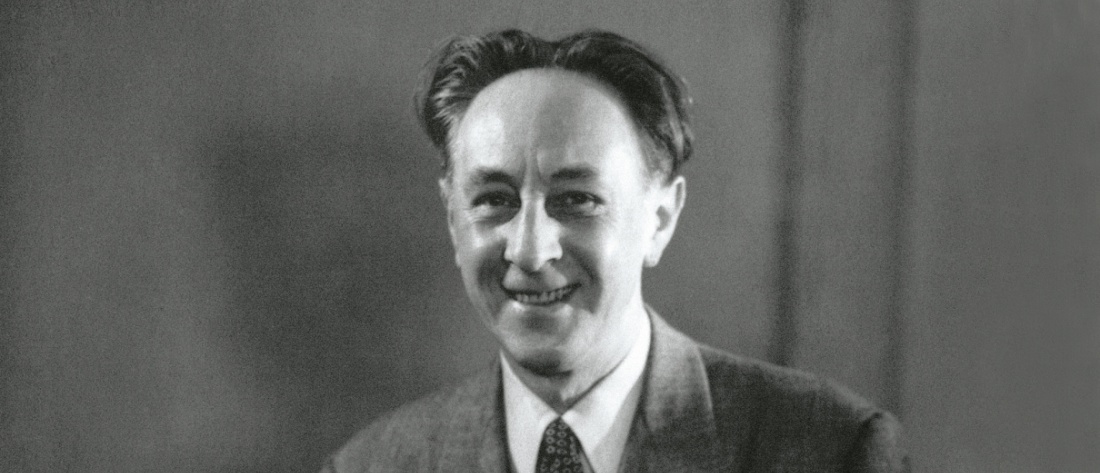
We performed the opera in 1978 at the DuPage Opera Theater at College of DuPage in Glen Ellyn, Illinois. Harold Bauer conducted the DuPage Philharmonic . . . I sang the role if Martin Avdeitch. I am very fond of this work as it was my first opera role 🙂